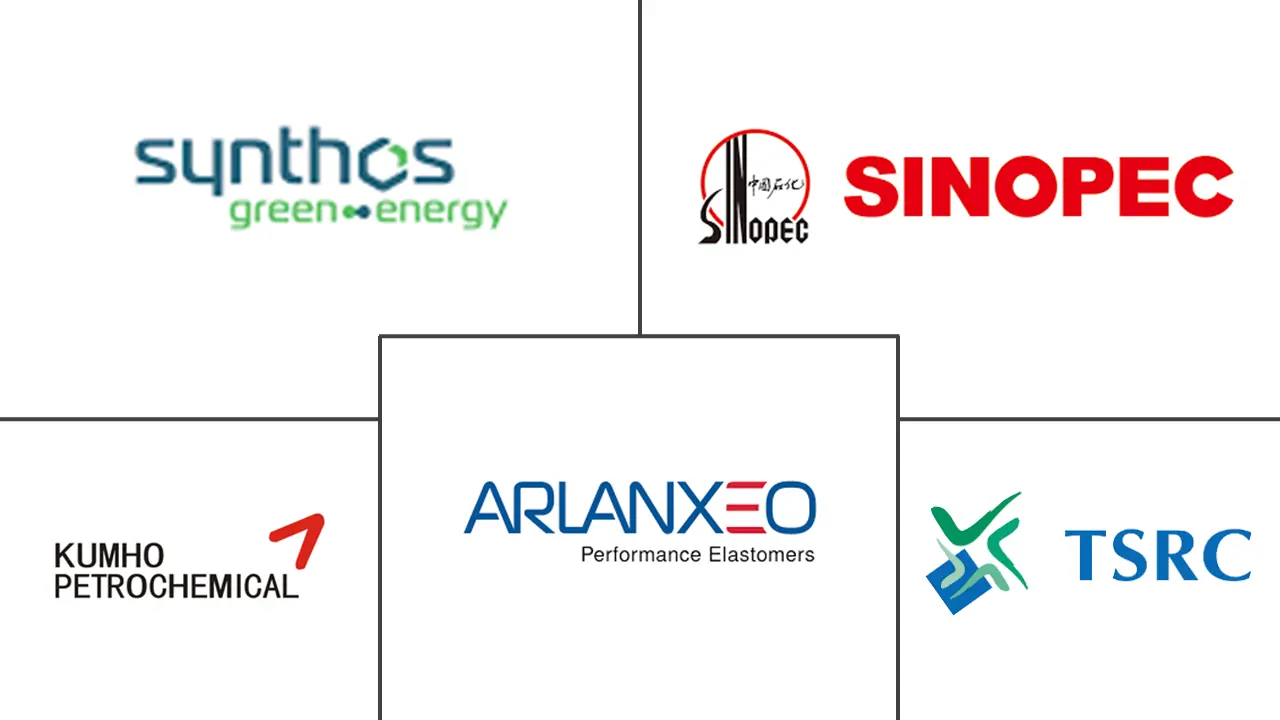Styrene Butadiene Rubber (SBR) Market Size and Share
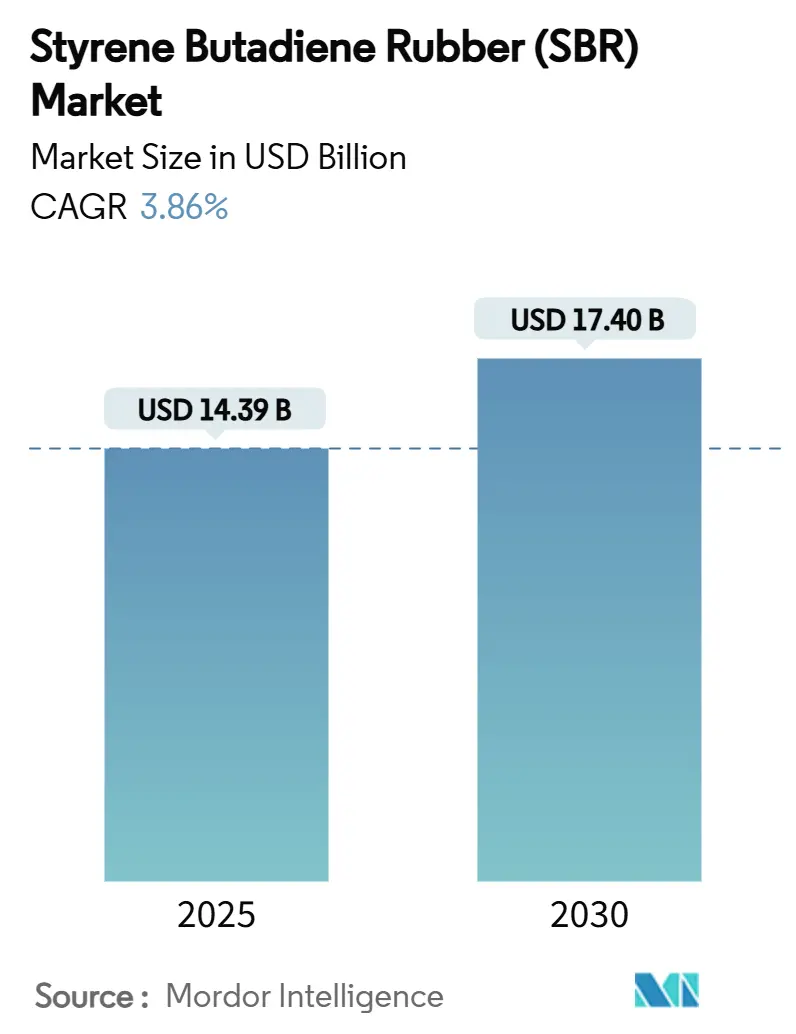
Styrene Butadiene Rubber (SBR) Market Analysis by Mordor Intelligence
The Styrene Butadiene Rubber Market size is estimated at USD 14.39 billion in 2025, and is expected to reach USD 17.40 billion by 2030, at a CAGR of 3.86% during the forecast period (2025-2030). Strong tire demand in emerging economies, sustained infrastructure investment, and mandatory sustainability regulations shape this moderate growth path. Investments in low-rolling-resistance tire technology, expanding adhesive usage in construction and packaging, and polymer-modified asphalt specifications all strengthen the consumption outlook. At the same time, crude-linked feedstock volatility, stricter carbon rules, and mounting competition from thermoplastic elastomers temper volume and pricing power. Asian manufacturing clusters reinforce global leadership by pairing large-scale capacity with proximity to automotive customers, whereas Western producers pursue divestitures and sustainable product pivots to protect margins.
Key Report Takeaways
- By type, emulsion SBR held 71.13% of the Styrene Butadiene Rubber market share in 2024, while solution SBR posted the fastest 4.34% CAGR to 2030.
- By application, tires accounted for 69.38% of the Styrene Butadiene Rubber market size in 2024; adhesives are on track for the highest 4.52% CAGR through 2030.
- By geography, Asia-Pacific commanded 45.64% revenue in 2024 and is advancing at a 4.28% CAGR up to 2030.
Global Styrene Butadiene Rubber (SBR) Market Trends and Insights
Driver Impact Analysis
| Driver | (~) % Impact on CAGR Forecast | Geographic Relevance | Impact Timeline |
|---|---|---|---|
| Tire replacement demand spike in emerging economies | +0.8% | Asia-Pacific, Latin America, MEA | Medium term (2-4 years) |
| Shift toward low-rolling-resistance tires in EU & China | +0.6% | Europe, China | Short term (≤2 years) |
| Rapid highway & airport construction boosting polymer-modified asphalt | +0.4% | Global, concentrated in Asia-Pacific | Long term (≥4 years) |
| OEM push for 10% tread weight reduction via functionalised S-SBR | +0.3% | Global automotive hubs | Medium term (2-4 years) |
| Mandatory wet-grip labelling in ASEAN spurring high-vinyl S-SBR uptake | +0.2% | ASEAN markets | Short term (≤2 years) |
| Source: Mordor Intelligence | |||
Tire Replacement Demand Spike in Emerging Economies
Vehicle fleet expansion combined with improved road networks significantly raises tire wear rates, pushing Styrene Butadiene Rubber market demand for tire compounds. Replacement tires already contribute 60% of total tire consumption in India, and Bridgestone has responded by committing USD 85 million to expand local production capacity. Radial tire adoption multiplies SBR usage per unit, further escalating volumes. Replacement cycles remain less affected by economic slowdowns than OEM demand, providing downside protection during industry troughs. Emerging Asia and Latin America therefore deliver a reliable mid-term uplift to global sales.
Shift Toward Low-Rolling-Resistance Tires in EU & China
Regulations aimed at fleet fuel efficiency elevate demand for solution SBR grades that enable silica-filled tread compounds with lower hysteresis. EU consumer labeling has already shifted purchasing toward A-rated rolling-resistance products, with manufacturers recording 15-20% volume growth in these premium categories[1]European Commission, “Tire Labeling Regulation Impact Assessment,” ec.europa.eu. China mirrors the trend in heavy-duty segments, translating to sizeable opportunities for suppliers capable of advanced functionalisation. The widening performance gap between emulsion and solution SBR reinforces price premiums for high-spec polymers while rewarding R&D-driven producers.
Rapid Highway & Airport Construction Boosting Polymer-Modified Asphalt
Asia-Pacific infrastructure programs accelerate consumption of SBR-modified asphalt that delivers enhanced rutting resistance and flexibility. Laboratory data show 18.8% higher stability and 46.2% stronger dynamic creep stiffness when 5% SBR is blended into asphalt binders[2]Illinois Department of Transportation, “Polymer Modified Asphalt Performance Study,” idot.illinois.gov. Such performance gains justify the material premium for runways and expressways exposed to extreme loads. Because infrastructure spending is usually multi-year, the application gives producers a long-wave demand pillar that diversifies away from cyclical automotive sales and strengthens the Styrene Butadiene Rubber market.
OEM Push for 10% Tread Weight Reduction via Functionalised S-SBR
Automakers require lighter tires to improve fuel economy and extend electric vehicle range, stimulating uptake of functionalised S-SBR with stronger filler bonds. Michelin’s roadmap to produce bio-based synthetic rubber with 40% renewable content by 2030 underscores this objective. Weight-reduction programs favour suppliers that provide low-density yet durable tread polymers, creating premium margin pools. The resulting design complexity raises switching costs, deepening customer relationships for incumbents with advanced compounding know-how.
Restraint Impact Analysis
| Restraint | (~) % Impact on CAGR Forecast | Geographic Relevance | Impact Timeline |
|---|---|---|---|
| Crude-linked butadiene price volatility | -0.7% | Global | Short term (≤2 years) |
| Growing TPE substitutes in footwear | -0.3% | Global, concentrated in Asia-Pacific | Medium term (2-4 years) |
| EU CBAM extending to synthetic rubber imports post-2027 | -0.2% | Europe, trade partners | Long term (≥4 years) |
| Recycling quotas in China cutting virgin SBR demand for conveyor belts | -0.1% | China, spillover to Asia-Pacific | Medium term (2-4 years) |
| Source: Mordor Intelligence | |||
Crude-Linked Butadiene Price Volatility
Feedstock costs typically represent up to 70% of total SBR manufacturing expenses, leaving margins exposed when crude prices spike. Currency swings add a further layer of unpredictability for exporters. While natural rubber rallies in 2024 temporarily improved SBR’s relative cost position, dual increases in crude derived butadiene quickly eroded that advantage. Long-term supplier contracts with fixed pricing clauses limit the industry’s ability to pass on sudden feedstock hikes, forcing many firms to adopt hedging and inventory strategies that raise working capital requirements.
Growing TPE Substitutes in Footwear
Footwear brands increasingly specify thermoplastic elastomers to streamline injection-molding processes and support recyclability commitments. TPE materials also simplify color matching and reduce cure times, compressing production cycles. Although SBR retains superior abrasion resistance for demanding athletic soles, casual and fashion segments migrate toward TPE at an accelerating pace. The shift pressures Styrene Butadiene Rubber industry volumes in a historically stable end-use segment, stimulating research into more sustainable SBR grades.
Segment Analysis
By Type: Solution SBR Drives Premium Applications
Solution SBR recorded the highest 4.34% CAGR through 2030, even though emulsion SBR controlled 71.13% of 2024 volumes. The Styrene Butadiene Rubber market size attributed to solution grades is projected to expand from USD 4.08 billion in 2025 to USD 5.06 billion in 2030, reflecting granular demand for high-performance tire treads. Functionalised solution polymers achieve tighter molecular weight distributions and superior filler compatibility, enabling tread weight reductions without compromising wet grip. ARLANXEO’s recent capacity addition in Dormagen aligns with automaker requirements for low-rolling-resistance tires. As performance specifications tighten, solution SBR gains share, particularly in Europe, China, and premium replacement markets where consumer awareness is highest. Emulsion SBR remains indispensable in mass-market segments thanks to scale advantages, extensive installed reactor base, and wide compounding latitude. Yet its price-driven positioning leaves margins vulnerable to feedstock swings. Blended distribution strategies that pair low-cost emulsion platforms with premium solution offerings thus protect revenue streams across automotive cycles.
The Styrene Butadiene Rubber market share commanded by solution grades is likely to rise by 3 percentage points by 2030, supported by ongoing tire label regulation, electric vehicle proliferation, and OEM sustainability targets. Even in cost-sensitive emerging economies, policy-driven requirements for wet-grip and rolling-resistance performance accelerate migration to solution SBR. Producers investing in continuous processes, advanced catalyst systems, and in-line functionalisation can capture premium pricing while lowering variable costs via energy efficiency improvements and digitalised plant control.
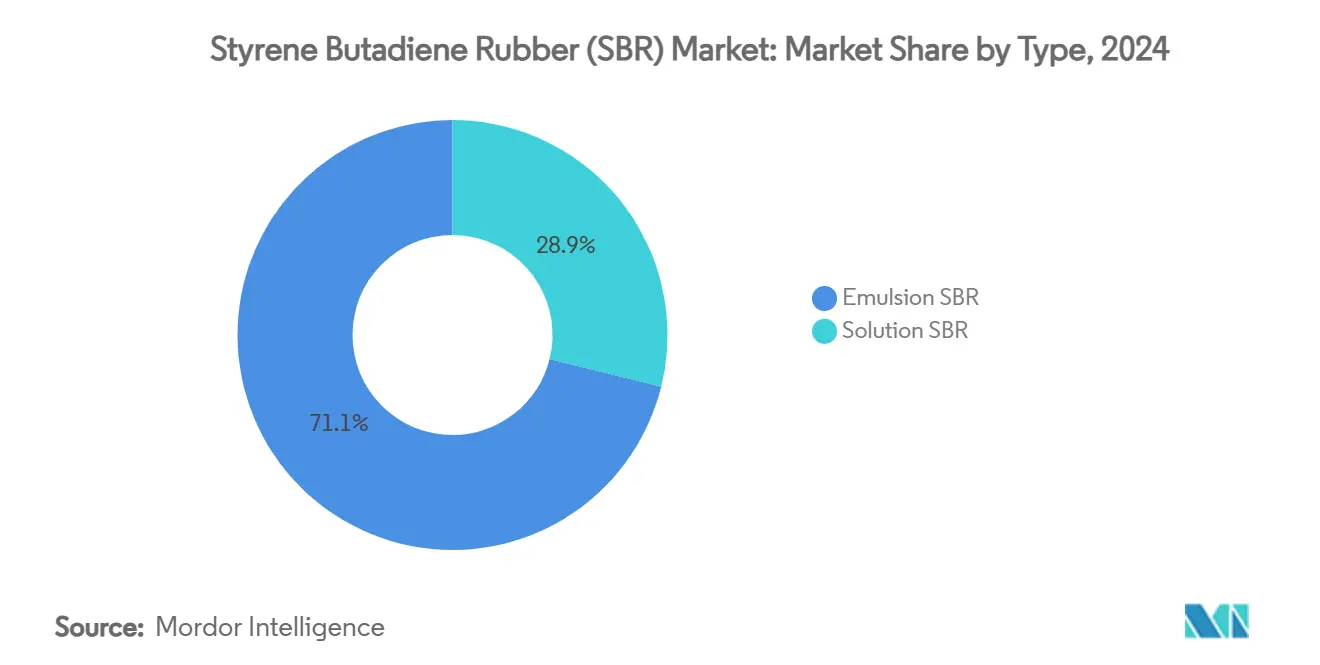
Note: Segment shares of all individual segments available upon report purchase
By Application: Adhesives Emerge as Growth Driver
Tires contributed 69.38% of 2024 revenue, anchoring overall Styrene Butadiene Rubber market demand. The segment benefits from resilient replacement cycles, with commercial vehicle fleets valuing SBR’s abrasion resistance and cost-effectiveness. However, adhesives represent the most dynamic application, advancing at 4.52% CAGR toward 2030. The Styrene Butadiene Rubber market size for adhesives is set to increase from USD 1.12 billion in 2025 to USD 1.39 billion by 2030 as construction outlays, e-commerce packaging volumes, and do-it-yourself consumer projects rise. SBR-based emulsions deliver strong adhesion on porous substrates like concrete and cardboard, combined with flexibility needed for temperature cycling. Packaging firms also adopt SBR hot-melt formulas that support mono-material recycling streams, helping them meet circular-economy pledges. Concurrently, high-growth Asian residential development fuels demand for tile adhesives, waterproof coatings, and sealants that require elastomer modification for crack bridging and impact resistance.
While footwear compound demand faces TPE substitution, premium athletic shoes still rely on SBR’s wear characteristics in high-abrasion outsole segments. Industrial goods including drive belts, hoses, and vibration isolators provide additional diversification, stabilising producer order books when automotive production fluctuates. These varied applications collectively reinforce the Styrene Butadiene Rubber market’s multi-sector resilience, though strategic focus is shifting toward higher-margin, differentiated formulations rather than pure volume pursuits.
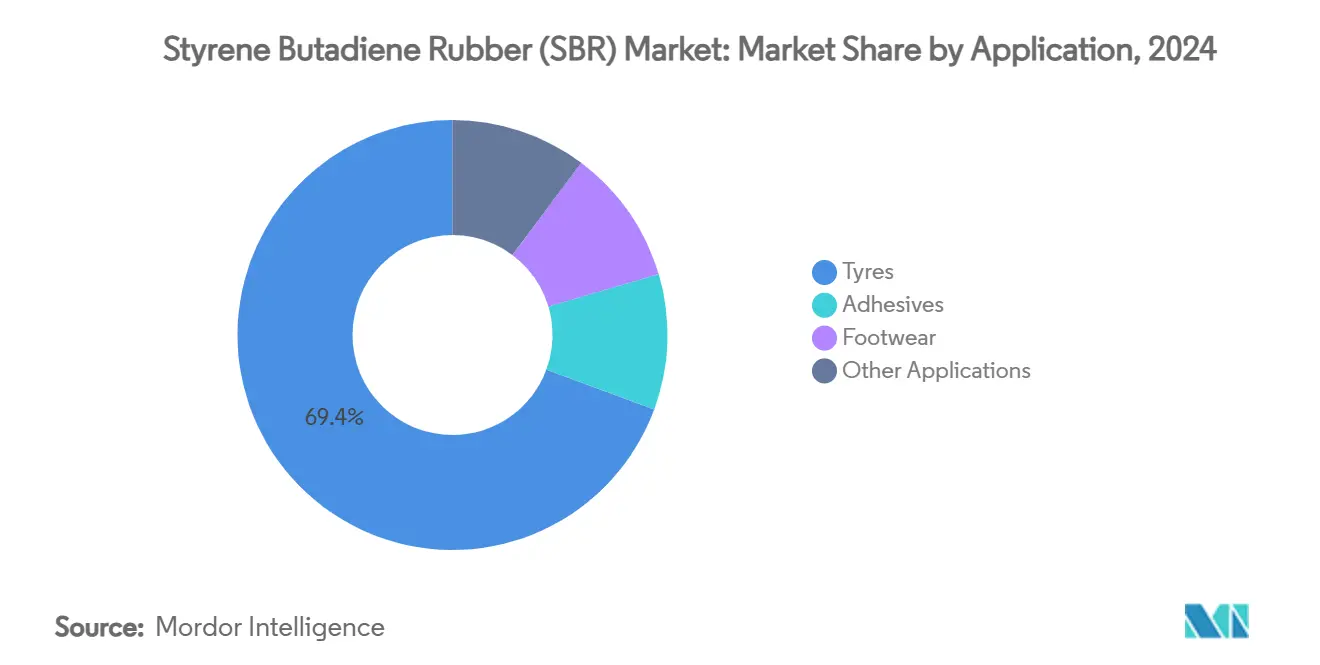
Note: Segment shares of all individual segments available upon report purchase
Geography Analysis
Asia-Pacific maintained 45.64% revenue share in 2024 and is projected to grow at 4.28% CAGR through 2030. China anchors regional dominance with extensive captive tire and synthetic rubber capacity, enabling fast scale-up for both emulsion and solution grades. Domestic demand receives a boost from rising car parc, infrastructure stimulus, and national recycling quotas that release capacity for export. India’s market is propelled by a forecast doubling of tire industry revenue to USD 22 billion by 2032, spurring incremental capacities and backward integration investments. Thailand and Malaysia complement upstream supply via natural rubber output, affording compounders integrated sourcing advantages. However, carbon pricing, stricter air-emission norms, and water-pollution controls could trigger cost escalations or relocation of older SBR assets within the bloc.
North America delivers mature yet steady consumption underpinned by replacement tires, polymer-modified asphalt for highway rehabilitation, and adhesive uptake in e-commerce packaging. United States tire makers continue to emphasise performance niches such as light-truck and ultra-high-performance variants that lean heavily on functionalised solution SBR. Mexico’s emergence as a near-shoring hub for motor vehicle assembly adds incremental demand for automotive rubber parts. Canadian mining and oil sands operations keep industrial SBR uses buoyant, particularly in conveyor belts and protective coatings. Overall, regional growth hovers close to the global average but skews toward higher value polymers.
Europe is constrained by a lower vehicle production trajectory but benefits from the EU’s sustainability agenda that favours advanced and lower-carbon SBR. German, French, and Italian tire plants intensify adoption of eco-performance grades, amplifying imports of solution SBR from Korea and Singapore until European capacity expands. Eastern European highway and airport upgrades stimulate polymer-modified asphalt usage, partially offsetting automotive softness. The upcoming CBAM will likely curtail high-carbon imports and encourage local sourcing or renewable-energy upgrades in exporting countries. Scandinavian and Benelux markets lead on recycled SBR applications in flooring and sports surfaces, fostering niches that valorise circular solutions.
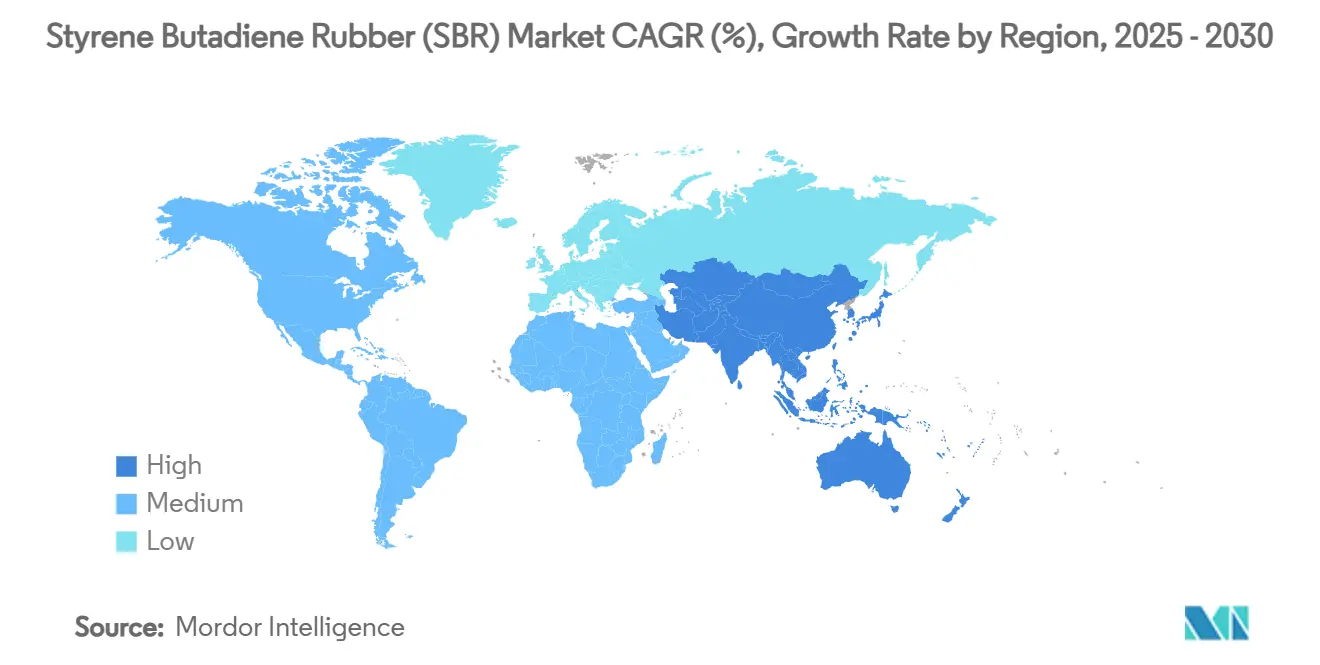
Competitive Landscape
The Styrene Butadiene Rubber market is moderately concentrated, with the top five players accounting for an estimated 56% of global revenue. ARLANXEO, LANXESS, and JSR Corporation retain competitive advantage through process technology, diverse product portfolios, and integration with butadiene feedstock. ARLANXEO’s Dormagen line upgrade lifts annual solution SBR output by 70 kilotonnes, targeting premium EU tire customers. LANXESS leverages backward integration into anionic polymerisation catalysts, lowering variable costs. JSR expands capacity in Yokkaichi to service domestic automakers’ high-specification requests.
Chinese entrants such as Sinopec and TSRC are adding emulsion and solution reactors to supply fast-growing domestic consumption and pursue export share, intensifying price pressure in commodity grades. Western incumbents respond by pruning non-core assets, exemplified by Goodyear’s USD 650 million sale of its Beaumont synthetic rubber business to Gemspring Capital in 2025. Partnerships around circularity are emerging as decisive. Sumitomo Rubber collaborates with Mitsubishi Chemical to recycle recovered carbon black into new tire compounds, reinforcing its cradle-to-cradle narrative. Michelin’s commitments to bio-based feedstocks and next-generation pyrolysis showcase how sustainability driven differentiation trumps pure capacity expansion in the long term.
Styrene Butadiene Rubber (SBR) Industry Leaders
-
ARLANXEO
-
China Petrochemical Corporation (Sinopec)
-
Kumho Petrochemical
-
Synthos
-
TSRC
- *Disclaimer: Major Players sorted in no particular order
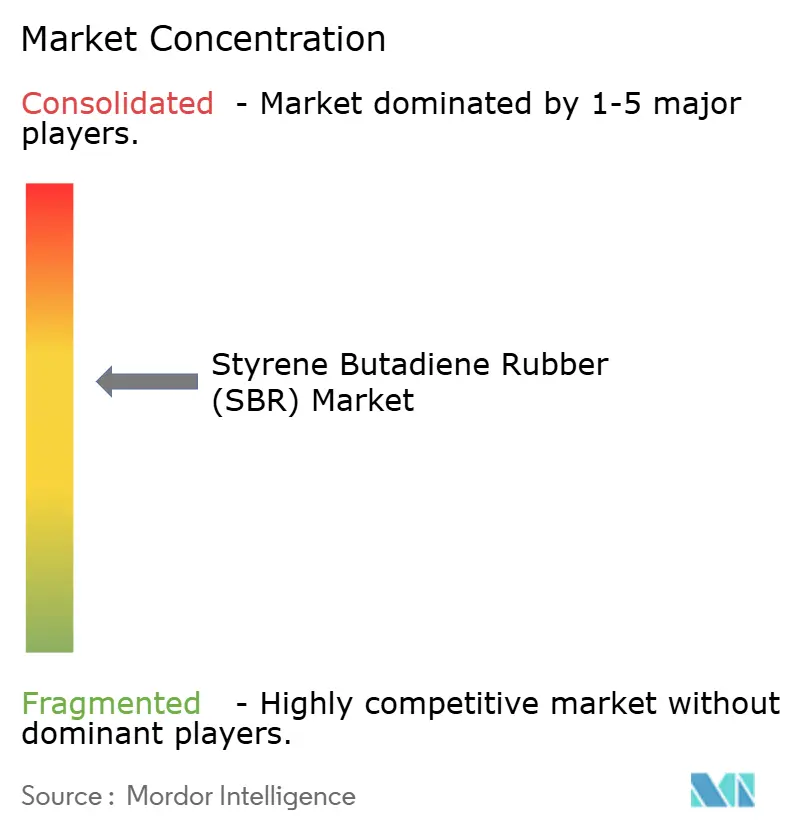
Recent Industry Developments
- December 2023: Synthos signed a Memorandum of Understanding (MOU) with Kumho Tire - a leading South Korean tire manufacturer. This collaboration is intended to develop sustainable raw materials for tires.
- April 2023: Hainan Baling Chemical New Material Co. Ltd, a subsidiary of China Petroleum & Chemical Corporation, started the production of production of its styrene-butadiene copolymer (SBC) in Hainan, China. This is intended to produce 170,000 tons of SBR annually. The company invested USD 279.74 million in this project.
Global Styrene Butadiene Rubber (SBR) Market Report Scope
Styrene butadiene rubber (SBR) is a synthetic rubber copolymer derived from the polymerization of styrene and butadiene. It is one of the majorly widely used synthetic rubbers because of its excellent abrasion resistance, good aging properties, and high resilience. SBR offers a balance of properties, making it suitable for various applications across various industries.
The styrene butadiene rubber market is segmented by type, application, and geography. By type, the market is segmented into emulsion SBR and solution SBR. The market is segmented by application into tires, adhesives, footwear, and other applications (construction materials). By geography, the market is segmented into Asia-Pacific, North America, Europe, South America, and Middle East & Africa. The report also covers the market size and forecasts for the styrene butadiene rubber market in 27 countries across major regions. The market sizing and forecasts are made for each segment based on revenue (USD).
| Emulsion SBR |
| Solution SBR |
| Tyres |
| Adhesives |
| Footwear |
| Other Applications |
| Asia-Pacific | China |
| Japan | |
| India | |
| South Korea | |
| Thailand | |
| Malaysia | |
| Vietnam | |
| Indonesia | |
| Rest of Asia-Pacific | |
| North America | United States |
| Canada | |
| Mexico | |
| Europe | Germany |
| France | |
| United Kingdom | |
| Italy | |
| Spain | |
| Nordic | |
| Turkey | |
| Russia | |
| Rest of Europe | |
| South America | Brazil |
| Argentina | |
| Colombia | |
| Rest of South America | |
| Middle East and Africa | Saudi Arabia |
| United Arab Emirates | |
| Qatar | |
| Egypt | |
| Nigeria | |
| South Africa | |
| Rest of Middle East and Africa |
| By Type | Emulsion SBR | |
| Solution SBR | ||
| By Application | Tyres | |
| Adhesives | ||
| Footwear | ||
| Other Applications | ||
| By Geography | Asia-Pacific | China |
| Japan | ||
| India | ||
| South Korea | ||
| Thailand | ||
| Malaysia | ||
| Vietnam | ||
| Indonesia | ||
| Rest of Asia-Pacific | ||
| North America | United States | |
| Canada | ||
| Mexico | ||
| Europe | Germany | |
| France | ||
| United Kingdom | ||
| Italy | ||
| Spain | ||
| Nordic | ||
| Turkey | ||
| Russia | ||
| Rest of Europe | ||
| South America | Brazil | |
| Argentina | ||
| Colombia | ||
| Rest of South America | ||
| Middle East and Africa | Saudi Arabia | |
| United Arab Emirates | ||
| Qatar | ||
| Egypt | ||
| Nigeria | ||
| South Africa | ||
| Rest of Middle East and Africa | ||
Key Questions Answered in the Report
What is the current size of the Styrene Butadiene Rubber market?
The Styrene Butadiene Rubber market size reached USD 14.39 billion in 2025, and it is forecast to hit USD 17.4 billion by 2030.
Which region leads global consumption?
Asia-Pacific dominates with 45.64% revenue share thanks to extensive tire and synthetic rubber manufacturing capacity combined with strong domestic demand growth.
Why is solution SBR gaining share over emulsion grades?
Solution SBR offers superior rolling-resistance and wet-grip performance, meeting tighter tire labeling rules and OEM efficiency targets, which drives its 4.34% CAGR through 2030.
How will the EU CBAM affect SBR trade?
From 2027, carbon levies on synthetic rubber imports will raise costs for carbon-intensive producers, encouraging European buyers to source lower-emission material or domestic supply.
Page last updated on:
